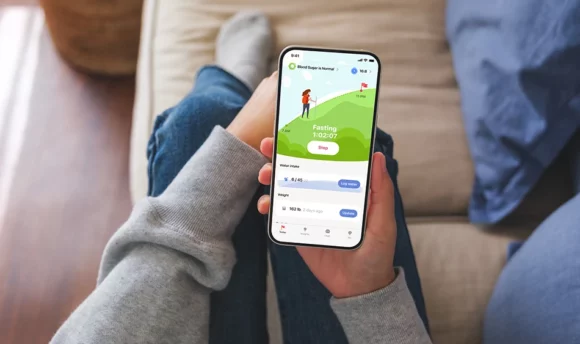Keto and Intermittent Fasting: Unlocking the Benefits
Both keto diet and intermittent fasting might help to lose weight but should you combine them together?

The keto diet and intermittent fasting are today’s most popular methods of achieving health and wellness. Besides health benefits, they carry excellent weight-loss-aiding properties.
While the ketogenic diet emphasizes the consumption of low-carb and high-fat meals, which are then used as energy, intermittent fasting works by adhering to a time-restricted eating schedule.
While both have substantial scientific research to back up their claimed benefits, you may be wondering if combining these two dieting methods is effective and safe.
This article delves into everything IF and keto, looking at how they work, how they can benefit you, and how you can successfully combine them.
Keto and Intermittent Fasting: Should You Combine These Two Diets?
Most people can safely combine the ketogenic diet with intermittent fasting. However, people with a history of eating disorders and pregnant or breastfeeding women should avoid dieting at all.
Those with diabetes, chronic kidney diseases, heart disease, or undergoing active cancer treatment should consult a doctor before attempting intermittent fasting on the keto diet.
Combining these two diets can help burn more fat than following either one alone. This is because limiting the time you consume carbs actively may cause your body to enter ketosis more quickly and speed up metabolism by promoting heat production, which causes the body to begin burning fat. This makes it easier to manage weight.
In addition to preserving muscle mass, intermittent fasting can also improve energy levels, benefiting people on a keto diet who want to lose weight and improve athletic performance.
Studies also show that intermittent fasting can help reduce hunger pangs and increase feelings of fullness, resulting in effective weight loss.
While some people may find it beneficial to combine the diets, not everyone may find it helpful.
It may be hard for some people to fast on a keto diet, or they may experience intermittent fasting side effects such as irritability, fatigue, and excess eating on non-fasting days.
What Is Intermittent Fasting?
Intermittent fasting (IF) is a diet that involves eating at a specific time each day, then fasting for a certain period. Fasting for a set number of hours daily or eating only one meal several days per week can help your body burn fat.
Intermittent fasting has been around for thousands of years in many cultures. In the modern world, it has become popular due to its many health benefits.
Some people swear by the eating pattern because it helps them manage their appetite and weight while supporting optimal health.
It’s not just about losing weight or getting in shape – studies have shown that intermittent fasting can help fight cancer, improve heart health and even treat depression.
There are many different intermittent fasting methods, but most people use the 16/8 method because it is one of the easiest regimens to follow. This means that you fast for 16 hours and eat during your remaining 8 hours.
IF, however, may not be suitable for everyone, either because of health concerns or because it does not meet their nutritional needs and leads to malnutrition.
What Is the Keto Diet?
The ketogenic diet entails consuming very few carbohydrates (less than 50 grams of net carbs daily). This includes avoiding sugar, grains, and refined carbohydrates like pasta and rice. The keto diet allows the consumption of enough protein, non-starchy vegetables, leafy greens, high-fat foods, and low-carb nuts and seeds.
The idea behind the keto diet is that by restricting carbohydrates, you enter a state of ketosis where your body starts burning fat instead of carbs and proteins for energy. You lose weight quickly because you’re not consuming any carbohydrates.
This diet is already popular for weight loss and blood sugar control benefits. As a result of limiting your carb intake, your body will begin to use fat for energy, resulting in normalized blood sugar levels and an increase in insulin sensitivity.
This high-fat/low-carb eating plan is also beneficial for people with ADHD (attention deficit hyperactivity disorder), epilepsy, or other seizure disorders because it reduces the frequency and severity of seizures while reducing or completely stopping medication requirements.
While people can succeed on any diet, many find that their health improves significantly when they switch from a standard American diet (SAD) to a ketogenic diet.
Should I fast before starting keto?
Keto dieters who have been on keto for more than two weeks and wish to add IF may do so with their doctor’s approval. Your body needs time to adjust to keto-adaptation; therefore, if you want to incorporate fasting into your routine, ensure you have a full week of eating keto before starting intermittent fasting. This will help overcome any keto flu symptoms.
Those suffering from the keto flu typically have symptoms for about a week, though some suffer even longer.
If you’re new to the keto diet and are just starting, it’s important to start slowly. The first two weeks of the diet can be tough, so give yourself enough time to get used to the changes before adding in fasting or IF.
If you have any medical conditions or are taking medications, it is also a good idea to consult your doctor before starting a fast.
What Is Ketosis? 4 Benefits of It
Ketosis is a metabolic process in the body that allows it to use fat as its primary energy source instead of carbohydrates. This occurs when your liver breaks down fat into ketones and uses them as energy.
Ketosis can be used as an effective weight loss tool, especially if you’re trying to lose weight while eating a low-carb diet.
The best time to induce ketosis is during a fast, changing to a ketogenic diet, or when you’re exercising at high intensity for prolonged periods of time, such as marathon training.
You can achieve ketosis by eating fewer than 50 grams of carbs per day, but most people find that they reach ketosis when they eat less than 20 grams per day. Here are the four major benefits of ketosis:
#1 Weight loss
When you follow a very low-carb diet, your body uses ketones – the fats produced in the liver to fuel the body. This can result in significant fat and weight loss over time.
Additionally, ketosis makes people on a ketogenic diet feel less hungry and satiated. Consequently, following the diet doesn’t require calorie counting.
#2 Decreased inflammation
When you follow a keto diet and are consistently in a state of ketosis, your body produces BHB (ß-hydroxybutyrate) ketones, a powerful anti-inflammatory chemical. BHB ketones block an inflammatory pathway known as NLRP3 inflammasome. By suppressing this pathway, research suggests keto may curb various inflammatory diseases.
The keto diet also encourages the consumption of anti-inflammatory foods such as olive oil, eggs, avocados, coconut oil, and other foods rich in omega-3s, all of which are hailed for their anti-inflammatory properties. Inflammatory foods are also discouraged in the diet plan.
#3 Boosts immune system
Studies suggest that a keto diet can improve the gut microbiome, decreasing leaky gut instances and balancing gut flora. A healthy gut microbiome is crucial to a healthy immune system.
A diet high in green vegetables and proteins and foods high in vitamin C helps strengthen our immune system. Switching to a keto diet may help boost the immune system, making it better equipped to fight off infections.
#4 Improves digestion
Keto benefits your gut bacteria – studies have shown that a ketogenic diet improves gut balance in infants and rodents.
Additionally, you get all your fiber practically from vegetables on a well-balanced keto diet. Veggies are high in prebiotic fiber, which feeds your good gut bacteria and helps them thrive.
High-fat, low-carb foods rich in fiber also starve bad gut bacteria, allowing good gut bacteria to thrive.
Does Intermittent Fasting Put You in Ketosis?
Intermittent fasting can help the body enter ketosis faster than the keto diet. That’s because the body maintains energy balance while fasting by shifting its energy source from carbs to fat, which is the first step in the keto diet. Fasting causes insulin and glycogen stores to deplete, causing the body to begin burning fat naturally.
Fasting increases ketone levels more. According to research, ketogenic diets can increase ketones fourfold, whereas fasting can increase ketones up to twentyfold. As a result, intermittent fasting benefits may be more substantial to your overall health than that of the ketogenic diet.
Your body may enter ketosis after only 12 hours of fasting, which many people do overnight before “breaking a fast” with a morning meal. If you take a midnight snack, it will prevent this process. With a keto diet, you stay in ketosis for much longer since you avoid carbohydrates, which supply glucose.
There are many different intermittent fasting methods, from the traditional 16/8 schedule to the 5:2 method. The most popular form of intermittent fasting is probably the 16/8 method, which consists of going without food for 16 hours a day of the fast, followed by an 8-hour window of eating.
Theoretically, if you can consistently follow this kind of schedule, you should be able to enter into a state of ketosis.
How to Fast Intermittently on Keto?
To do intermittent fasting on keto, you’ll want to begin with a smaller fasting period, like 12 hours, or alternate day fasting, and gradually increase it. You can quickly achieve a 12-hour fast if you have an early dinner or a late breakfast and do not snack during that time.
Eat nothing during your fasting period. Water is essential if you have extended fasting periods. You may also consume fasting-friendly beverages such as plain water, black coffee, or tea. You can also add electrolytes to avoid keto flu.
During your eating window, refeed with well-balanced, nutritious meals. Don’t waste your eating window binging or eating unhealthy, processed foods. It’s also important to plan your meals earlier to avoid making last-minute food decisions when you’re already hungry.
Remember that no intermittent fasting periods work for everybody – experiment with different methods to find what works for you.
Benefits of Practicing Both Keto and Intermittent Fasting
While intermittent fasting benefits can be numerous, intermittent fasting combined with improved ketosis via a low-carb diet is far more effective. You can reap the following incredible benefits by incorporating intermittent fasting and keto:
#1 More effective weight loss
The keto diet combined with the fast may help you lose more weight than either diet alone. This is because intermittent fasting promotes thermogenesis, which boosts metabolism, making your body start burning stubborn fat.
According to an analysis of several studies, individuals who followed intermittent fasting lost an extra 7.3 pounds of fat mass more than those who followed very low-calorie diets. The results of this study support the idea that adding fasting to a carb-restricted keto diet can result in more weight loss.
Intermittent fasting may also enhance energy levels and preserve muscle mass during weight loss than daily carb restriction alone. This may appeal to keto enthusiasts who want to gain muscle while losing body fat.
Similarly, studies suggest intermittent fasting can reduce hunger and increase feelings of fullness, which may promote weight loss.
#2 Easier transition to ketosis
Fasting can speed up the keto diet’s ability to put your body into ketosis. When you fast, your body uses fat for fuel instead of carbs, which is exactly what the keto diet does.
Your insulin levels also begin to decrease when you fast for more than 12 hours, which is good for your metabolism.
When you have trouble getting into ketosis and staying there, combining keto and intermittent fasting can be particularly helpful.
You may improve your metabolism more quickly by adding fasting to the mix than by doing keto or intermittent fasting alone.
How Long Should You Fast on Keto?
Fasting on keto can be short or long periods, depending on what you find working for you. Some chose a 5:2 plan which involves eating keto meals for five days and then consuming fewer calories, about 500–600 calories for two days.
Another intermittent fasting schedule is 16/8, which involves eating keto meals for only eight hours a day. The easiest way to achieve this is to reduce your normal mealtimes or skip breakfast and eat two meals daily. You can perform this method daily, and it’s an excellent introductory fast for beginners and more experienced fasters.
You can also choose alternate-day fasting, which involves eating one day and fasting the next.
Longer fasts (while naturally increasing ketosis) can activate more benefits if done under medical supervision. If you fast for 72 hours or longer, you may experience even greater health benefits, particularly in reducing blood glucose levels and ketone production.
A Word From a Nutritionist
It’s critical to remember that keto and intermittent fasting have benefits and drawbacks. Following two diets simultaneously may put you at risk of experiencing double the side effects, especially if it’s your first time.
Low blood sugar, headaches, fatigue, mood swings, nausea, and constipation are common early stages. Also, combining the two diets requires much more patience and commitment because it is a restrictive eating method.
If you decide to try this diet combination, it is best to start slowly rather than all at once. During your eating window, eat foods that release energy slowly and don’t eliminate carbs entirely. You should avoid using this method if you have a history of eating disorders.
When you’re breaking a fast on keto, begin with simple foods that are easy for your body to digest. If you know a certain food causes you problems, avoid them. Instead, choose a keto diet rich in vegetables, broths, lean proteins, and soups that are easy on your digestive system.
Conclusion
Intermittent fasting combined with a low-carb diet may help you achieve ketosis faster than either diet alone. It may also lead to significant fat loss.
They both offer many potential benefits, and there is a great deal of overlap between them. This combination can be effective and safe for most people. Just remember to take it slowly and pay attention to your body. You should avoid fasting if you’re pregnant, breastfeeding, or have a history of disordered eating.
Remember that, as with any major diet or lifestyle change, it’s essential to consult a registered health professional, particularly if you are undergoing any medical treatment or on any prescribed medication.

















































 Select your language:
Select your language: 








